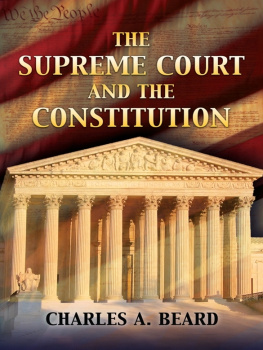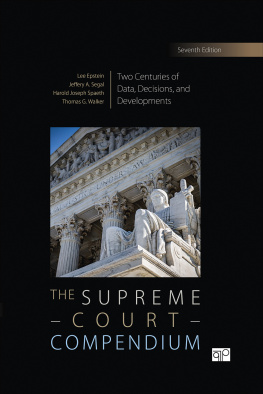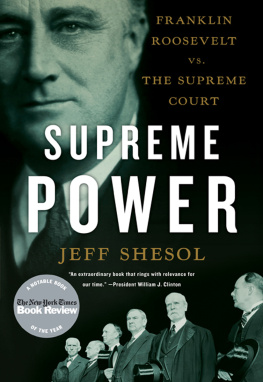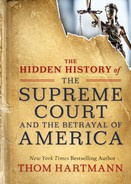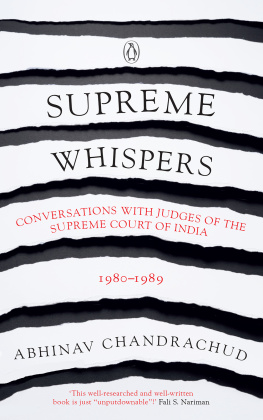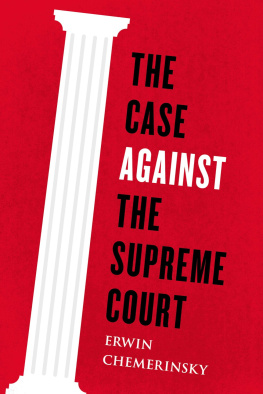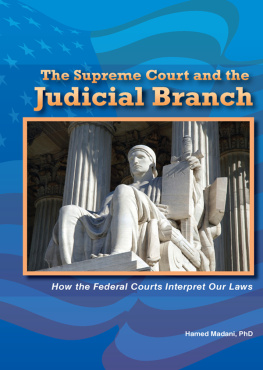Supreme Court of India
Supreme Court of India
The Beginnings
George H. Gadbois, Jr
Edited and introduced by
Vikram Raghavan and Vasujith Ram
Oxford University Press is a department of the University of Oxford.
It furthers the Universitys objective of excellence in research, scholarship,
and education by publishing worldwide. Oxford is a registered trademark of
Oxford University Press in the UK and in certain other countries.
Published in India by
Oxford University Press
2/11 Ground Floor, Ansari Road, Daryaganj, New Delhi 110 002, India
Oxford University Press 2017
Introduction Vikram Raghavan and Vasujith Ram
The moral rights of the authors have been asserted.
First Edition published in 2017
All rights reserved. No part of this publication may be reproduced, stored in
a retrieval system, or transmitted, in any form or by any means, without the
prior permission in writing of Oxford University Press, or as expressly permitted
by law, by licence, or under terms agreed with the appropriate reprographics
rights organization. Enquiries concerning reproduction outside the scope of the
above should be sent to the Rights Department, Oxford University Press, at the
address above.
You must not circulate this work in any other form
and you must impose this same condition on any acquirer
ePub ISBN-13: 978-0-19-909318-2
ePub ISBN-10: 0-19-909318-0
Disclaimer: The introduction reflects the editors personal views. It does not
represent the authors views or those of any institution or employer to
which the editors may be professionally associated.
Typeset in ITC Giovanni Std 9.5/13
by Tranistics Data Technologies, Kolkata 700091
Printed in India by Replika Press Pvt. Ltd
Contents
In undertaking this study of the paramount judiciary in India, an effort has been made to become familiar with virtually all the primary and secondary source material available on the subject, in order that a very comprehensive book might be written. Finding that much more material was available than could possibly be utilized in a single study, and discovering that much of the complexity and enigma of India is reflected in judicial decisions, the scope of this book had to be limited. The research reported in the opening two chapters on the Federal Court is probably sufficient to enable one to gain a general understanding of the limited role it played during its brief period of existence, for a substantial number of the relatively few decisions of the Federal Court are discussed. The Supreme Court, however, which replaced the Federal Court in 1950, and which is endowed with an extremely comprehensive jurisdiction, has handed down thousands of decisions over the past fifteen years bearing upon a bewildering variety of subjects. Of necessity, therefore, my treatment of the Supreme Court is limited in scope. Broadly speaking, the four chapters devoted to the Supreme Court seek to explore the role of the Supreme Court in the Indian political system. Considerable attention is devoted to the nature of the review powers exercised by the Supreme Court, to the expectations of the constitution-makers regarding the role of the Supreme Court, and to those decisions of the Supreme Court which have brought it into conflict with the Government.
I wish to express my deep gratitude to all those individuals and institutions who have been of assistance to me in the preparation of this book. My intellectual debts to Professors Ralph Braibanti and Richard Wheeler are especially great, for they aroused my interest in South Asia. In India I was assisted by, among others, former Chief Justice of India Bhuvaneshwar Prasad Sinha, and Dr. A. T. Markose, former Research Director of the Indian Law Institute. Mr. G. V. Mirchandani, Chief Librarian of the Library of Parliament, and Mr. Amreek Singh, Chief Librarian of the Supreme Court Library took a personal interest in my research, and were always helpful. The field research reported in the pages which follow was made possible through grants from the American Institute of Indian Studies, USA and the Duke University Commonwealth-Studies Center, USA. This financial support is gratefully acknowledged.
George H. Gadbois, Jr
April 1965
On a mid-September morning in 1962, a scooter rickshaw drove up New Delhis Hardinge Avenue. Lined with diplomatic residences, the road had been recently renamed Tilak Marg. At the intersection with Bhagwan Das Road, the three-wheeler turned right and halted to let out its passenger. A young, blond-haired American with tortoise-shell glasses emerged from the vehicle. In front of him was a majestic sandstone-dressed building with a colonnaded central verandah. Large pillars on the verandah supported a roof with protruding eaves. Above the roof rose an imposing dome with two companion canopies. The buildings arms emerged on either side of the courtyard to symbolize the scales of justice.
The structure did not figure in the British architect Edwin Lutyenss plans for the capital city. But Lutyens and his associate, Herbert Baker, clearly influenced Ganesh Deolalikar under whose supervision the edifice was erected in the late 1950s. It had been only four years since President Rajendra Prasad had inaugurated the building to house the Supreme Court of India. The Court had, as Prasad put it, finally acquired a habitat of its own.
On the pavement facing the building, the young American stood for a moment to take in the sight. And then he walked inside. A graduate student at Duke University, George H. Gadbois, Jr had been studying India for a few years. He had travelled to Delhi to do research for his doctoral dissertation in political science. After spending a year in the capital, Gadbois returned to the United States where he continued his work. He completed and submitted his dissertation in April 1965. Fifty-two years later, that dissertation is being edited and republished as this book.
I
Growing up in a hardscrabble Boston suburb, Gadbois worked his way through high school by delivering newspapers, shovelling snow, and caddying on golf courses. At seventeen, he enlisted in the United States Army. He was promptly sent to Taiwan from where his unit monitored Chinese aircraft movements on the mainland. After three years in the army, Gadbois wanted to become an officer. But he lacked a college degree. Determined to get one, he returned home in 1956 to enrol at Marietta College, a small liberal arts school in Ohio.
At Marietta, Gadbois took several classes with Robert Jones, a Harvard-trained agricultural historian. Jones had wide-ranging interests including European and African studies, and he left a formative impression on the young undergraduate. In college, Gadbois remained an active member of the army reserves. Gradually, however, his interest in a military career declined. He aspired to be a lawyer, but he lacked the funds to pursue that ambition. After considering careers in the Navy and the Central Intelligence Agency (CIA), he decided to try his hand at teaching.
Gadbois obtained a fellowship to attend Duke University and moved to Durham, North Carolina in 1959. His first preference was to focus on China because he had really enjoyed his time in Taiwan. But Duke had no subject expert who could guide him. And convinced that he was not very good at languages, Gadbois doubted whether he would ever become fluent in Mandarin. Thus, abandoning his initial attempt to study China, Gadbois turned instead to India.





